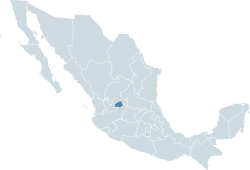Municipalities of Aguascalientes

Municipalities (municipios in Spanish) are the second-level administrative division in Mexico. The Mexican state of Aguascalientes is subdivided into 11 municipalities. The internal political organization and their responsibilities are outlined in the 115th article of the 1917 Constitution[1] and further expanded in the constitution of the State of Aguascalientes. The largest municipality by population is Aguascalientes with 797,010 residents, whereas the smallest municipality by population is San José de Gracia with 8,443 residents.[2] The largest municipality by land area is also Aguascalientes with a land area of 1,178.85 km^2, and the smallest is Cosío with a land area of 128 km^2.[3]
Structure
Each municipality is administratively autonomous; citizens elect a "municipal president" (presidente municipal) who heads an ayuntamiento or municipal council, responsible for providing all the public services for their constituents. This concept, which originated after the Mexican Revolution, is known as a municipio libre ("free municipality"). A municipal president heads the ayuntamiento (municipal council). The municipal president is elected by plurality and cannot be reelected for the next immediate term. The municipal council consists of a cabildo (chairman) with a síndico and several regidores (trustees).
If the municipality covers a large area and contains more than one city or town (collectively called localidades), one city or town is selected as a cabecera municipal (head city, seat of the municipal government) while the rest elect representatives to a presidencia auxiliar or junta auxiliar (auxiliary presidency or council). In that sense, a municipality in Mexico is roughly equivalent to the counties of the United States, whereas the auxiliary presidency is equivalent to a township. Nonetheless, auxiliary presidencies are not considered a third-level administrative division since they depend fiscally on the municipalities in which they are located.
Municipalities may cover large areas incorporating several separated cities or towns that do not necessarily conform to one single conurbation, or large urban areas usually extend over several municipalities which form one single conurbation. Although an urban area might cover an entire municipality, auxiliary councils might still be used for administrative purposes.
Municipalities are responsible for public services (such as water and sewerage), street lighting, public safety, traffic, supervision of slaughterhouses and the cleaning and maintenance of public parks, gardens and cemeteries. They may also assist the state and federal governments in education, emergency fire and medical services, environmental protection and maintenance of monuments and historical landmarks. Since 1983, they can collect property taxes and user fees, although more funds are obtained from the state and federal governments than from their own collection efforts.
| INEGI code | Municipality | Municipal seat | Population (2010)[4] | Area (km²) |
|---|---|---|---|---|
| 001 | Aguascalientes | Aguascalientes | 797,010 | 1,178.85 |
| 002 | Asientos | Asientos | 45,492 | 547.74 |
| 003 | Calvillo | Calvillo | 54,136 | 931.26 |
| 004 | Cosío | Cosío | 15,042 | 128 |
| 005 | Jesús María | Jesús María | 99,590 | 499 |
| 006 | Pabellón de Arteaga | Pabellón de Arteaga | 41,862 | 199.33 |
| 007 | Rincón de Romos | Rincón de Romos | 18,828 | 376.77 |
| 008 | San José de Gracia | San José de Gracia | 8,443 | 856 |
| 009 | Tepezalá | Tepezalá | 19,668 | 231.70 |
| 010 | El Llano | Palo Alto | 18,828 | 500 |
| 011 | San Francisco de los Romo | San Francisco de los Romo | 35,769 | 139.54 |
References
External links
- (Spanish) Aguascalientes state government
- (Spanish) Enciclopedia de los Municipios de México
- (Spanish) INEGI